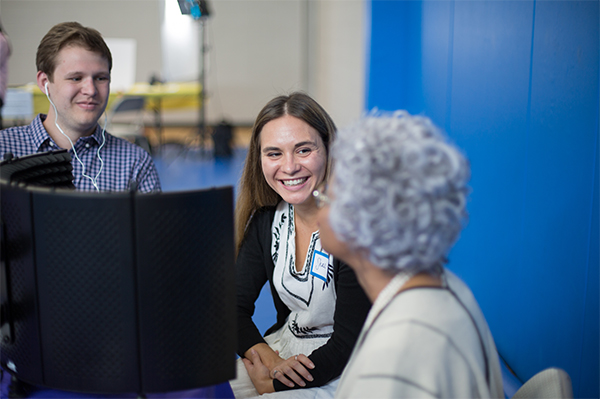
Is it possible to write objective history? Nine Samford University students wrestled with that idea in a special topics course on Faith and History this year. Professor Anthony Minnema developed the fall course with support from Samford’s William E. and Wylodine H. Hull Fund for Christian Scholarship, hoping to get students thinking about how historians’ unique identities–especially related to faith–shape their work.
Minnema said courses at other universities explore similar themes, but Samford’s course was enriched by a digital humanities component. He wanted students to collect oral histories from Birmingham-area historians and leaders of diverse faith traditions, so he asked oral history expert Michelle Little to introduce the students to the craft and instruct them in the development of podcasts based on their interviews. The students presented their podcasts at a public listening session earlier this year.
Having made the transition from media consumers to media creators, Minnema, said “the students are starting to see that this is a form of historical storytelling that really grabs people.” The work certainly grabbed Shae Corey, a junior history and secondary education major with a growing interest in the field of public history. She enjoyed it so much she served in an oral history internship in the spring and earned an ASPIRE research grant to help history professor Annie DeVries document the stories and artifacts and distinctive places of Birmingham’s Rosedale community this summer.
For Minnema’s course, Corey teamed with senior history major Jonathan Lawson to interview Matt Mason, Senior Pastor of The Church of Brook Hills in suburban Birmingham, and sister Elisabeth Meadows, Director of the Benedictine Retreat Center at the Sacred Heart Monastery in Cullman.
“It feels like you’re stepping back in time when you walk on the grounds of the monastery,” Lawson said. “You see images of sisters who have been there for generations.” The researchers noted that this everyday familiarity over decades gives the sisters a common personal story as well as a share in the history of their Roman Catholic Church. Without that long history, Corey observed, the Church at Brook Hills has the challenge of “reaching out for something new” in order to build a close community amidst the come-and-go of modern suburban life.
In spite of the very different ways these communities engage with history, Lawson and Corey both were struck by how much they have in common. “Pastor Mason and sister Meadows do things differently, but the ultimate goal is to praise God,” Lawson said.
Senior biology major Meg Alford and junior secondary education major Mattie Dew recorded the stories of the Reverend Arthur Price, Jr., pastor of Birmingham’s historic Sixteenth Street Baptist Church, and Traci Jones, who at the time was the Gallery Experience Manager for Birmingham Civil Rights Institute. Talking with the two, Alford said, helped her understand the city’s history and become more mindful not only of how the views of others are shaped, but how her own are shaped. “You have to see people as people, and we all have a story to tell,” Alford said.
That sense of documenting the stories of others while living one’s own was one of Minnema’s objectives for the students in his course. In the end, he said, they were less comfortable with the idea that objective history is possible or even desirable, and realized that “unless you let people express history and the work of writing history as an extension of their faith, you’re limiting them somehow.” “It’s inevitable that we bring in something of ourselves.”
